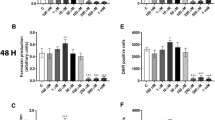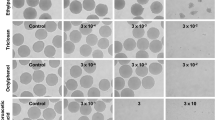Abstract
Perfluorooctane sulfonate (PFOS) is the degradation product of many fluoroderivatives and a widespread environmental contaminant. Its persistence, its long half-life in humans and its toxicity explain high concerns on human health side effects in future. PFOS is suspected to be a non-genotoxic carcinogen. In the present work, we assessed carcinogenic potential of PFOS by studying morphological transformation in Syrian hamster embryo (SHE) cells; cell transformation of SHE cells is an in vitro assay recommended by the Organization for Economic Cooperation and Development to detect carcinogens, genotoxic or not. Genotoxicity of PFOS and expression of PPARs genes in SHE cells were also measured. PFOS was shown to induce cell transformation (P < 0.05) at non-cytotoxic concentrations (0.2 and 2 μg/mL) (P ≤ 0.01). No genotoxic effect was recorded in the range of PFOS concentrations tested (2 × 10−4 to 50 μg/mL) using the single-cell gel electrophoresis (comet) assay after 5 and 24 h of exposure. The expression of PPARs genes was measured by qPCR within the first 24 h and after 7 days of PFOS treatment. Results indicated an increased expression of ppar-β/δ isoform as early as 24 h. After 7 days, the increase of ppar-β/δ mRNA was significant at the concentrations inducing cell transformation (0.2 and 2 μg/mL), while overexpression of ppar-γ and ppar-α did not closely relate to effective concentrations. The results indicate that PFOS behave as a non-genotoxic carcinogen and impacted PPARs genes. Its cell transforming potential paralleled an increased expression of ppar-β/δ.





Similar content being viewed by others
References
Abbott BD (2009) Review of the expression of peroxisome proliferator-activated receptors alpha (PPARα), beta (PPARβ), and gamma (PPARγ) in rodent and human development. Reprod Toxicol 27:246–257
Alexander BH, Olsen GW (2007) Bladder cancer in perfluorooctanesulphonyl fluoride manufacturing workers. AEP 17(6):471–478
Alexander BH, Olsen GW, Burris JM, Mandel JH, Mandel JS (2003) Mortality of employees of a perfluorooctanesulphonyl fluoride manufacturing facility. Occup Environ Med 60:722–729
Barak Y, Liao D, He W, Ong ES, Nelson MC, Olefsky JM, Boland R, Evans RM (2002) Effects of peroxisome proliferator-activated receptor delta on placentation, adiposity, and colorectal cancer. Proc Natl Acad Sci 99(1):303–308
Berthiaume J, Wallace KB (2002) Perfluorooctane, perfluorooctanesulfonate, and N-ethylperfluorooctanesulfonamido ethanol; peroxisome proliferation and mitochondrial biogenesis. Toxicol Lett 129:23–32
Berwald Y, Sachs L (1963) In vitro cell transformation with chemical carcinogens. Nature 200:1182–1184
Berwald Y, Sachs L (1965) In vitro transformation of normal cells to tumor cells by carcinogenic hydrocarbons. J Natl Cancer Inst 35:641–661
Calafat AM, Needham LL, Kuklenyik Z, Reidy JA, Tully JS, Aguilar-Villalobos M, Naeher LP (2006) Perfluorinated chemicals in selected residents of the American continent. Chemosphere 63:490–496
Calafat AM, Wong LY, Kuklenyik Z, Reidy JA, Needham LL (2007) Polyfluoroalkyl chemicals in the U.S. population: data from the National Health and Nutrition Examination Survey (NHANES) 2003–2004 and comparisons with NHANES 1999–2000. Environ Health Perspect 115(11):1596–1602
Decision SC-4/17 (2009) Decision to amend part I of Annex B of the Stockholm convention to list perfluorooctane sulfonic acid, its salts and perfluorooctane sulfonyl fluoride
De Boeck M, Touil N, De Visscher G, Aka Vande P, Kirsch-Volders M (2000) Validation and implementation of an internal standard in comet assay analysis. Mutat Res 469(2):181–197
Dreyer C, Krey G, Keller H, Givel F, Helftenbein G, Wahli W (1992) Control of the peroxisomal β-oxidation pathway by a novel family of nuclear hormone receptors. Cell 68:879–887
EFSA Journal (2008) Opinion of the scientific panel on contaminants in the food chain on perfluorooctane sulfonate (PFOS), perfluorooctanoic acid (PFOA) and their salts. Eur Food Saf Auth J 653:1–131
Elias Z, Poirot O, Pezerat H, Suquet H, Schneider O, Daniere MC, Terzetti F, Baruthio F, Fournier M, Cavelier C (1989) Cytotoxic and neoplastic transforming effects of industrial hexavalent chromium pigments in Syrian hamster embryo cells. Carcinogenesis 10:2043–2052
EU (2006) Directive 2006/122/ECOF of the European Parliament and of the Council of 12 December 2006. Official Journal of the European Union, L/372/32-34, 27 Dec 2006
Faust F, Kassie F, Knasmüller S, Boedecker RH, Mann M, Mersch-Sundermann V (2004) The use of the alkaline comet assay with lymphocytes in human biomonitoring studies. Mutat Res 566:209–229
Fromme H, Tittlemier SA, lkela WV, Wilhelm M, Twardellaa D (2009) Perfluorinated compounds—exposure assessment for the general population in western countries. Int J Hyg Environ Health 212:239–270
Giesy JP, Kannan K (2001) Global distribution of sulfonate de perfluorooctane in wildlife. Environ Sci Technol 35(7):1339–1342
He TC, Chan TA, Vogelstein B, Kinzler KW (1999) PPARdelta is an APC-regulated target of nonsteroidal anti-inflammatory drugs. Cell 99(3):335–345
Hu W, Jones PD, Upham BL, Trosko JE, Lau C, Giesy JP (2002) Inhibition of gap junctional intercellular communication by perfluorinated compounds in rat liver and dolphin kidney epithelial cell lines in vitro and Sprague-Dawley rats in vivo. Toxicol Sci 68:429–436
Hu W, Jones PD, Celius T, Giesy JP (2005) Identification of genes responsive to PFOS using gene expression profiling. Environ Toxicol Pharmacol 19:57–70
Isfort RJ, Leboeuf RA (1996) Application of in vitro cell transformation assays to predict the carcinogenic potential of chemicals. Mutat Res 365:161–173
Issemann I, Green S (1990) Activation of a member of the steroid hormone receptor superfamily by peroxisome proliferators. Nature 347:645–650
Jernbro S, Suares Rocha P, Keiter S, Skutlarek D, Färber H, Jones PD, Giesy JP, Hollert H, Engwall M (2007) Perfluorooctane sulfonate increases the genotoxicity of cyclophosphamide in the micronucleus assay with V79 cells. Further proof of alterations in cell membrane properties caused by PFOS. Environ Sci Pollut Res 14(2):85–87
Kannan K, Corsolini S, Falandysz J, Oehme G, Focardi S, Giesy JP (2002) Perfluorooctanesulfonate and related fluorinated hydrocarbons in marine mammals, fishes and birds from coasts of the Baltic and the Mediterranean seas. Environ Sci Technol 36(15):3210–3216
Kannan K, Corsolini S, Falandysz J, Fillman G, Kumar KS, Loganathan BG, Modh MA, Olivero J, Wouve NV, Yang JH, Aldous KM (2004) Perfluorooctane sulphonate and related fluorochemicals in human blood from several countries. Environ Sci Technol 38:4489–4495
Lau C, Thibodeaux JR, Hanson RG, Rogers JM, Grey BE, Stanton ME et al (2003) Exposure to perfluorooctane sulfonate during pregnancy in rat and mouse. II. postnatal evaluation. Toxicol Sci 74(2):382–392
Lau C, Butenhoff JL, Rogers JM (2004) The developmental toxicity of perfluoroalkyl acids and their derivatives. Toxicol Appl Pharmacol 198:231–241
Lau C, Anitole K, Hodes C, Lai D, Pfahles-Hutchens A, Seed J (2007) Perfluoroalkyl acids: a review of monitoring and toxicological findings. Toxicol Sci 99(2):366–394
Livak KJ, Schmittgen TD (2001) Analysis of relative gene expression data using real-time quantitative PCR and the \( 2^{{ - \Updelta \Updelta {\text{CT}}}} \) method. Methods 25:402–408
Luebker DL, Hansen KJ, Bass NM, Butenhoff JL, Seacat AM (2002) Interaction of flurochemicals with rat liver fatty acid-binding protein. Toxicology 176:175–185
OECD (2002) Hazard assessment of perfluorooctane sulfonate (PFOS) and its salts. ENV/JM/RD(2002)17/FINAL. Joint meeting of the chemicals committee and the working party on chemicals, pesticides, and biotechnology, Environment Directorate, Organisation for Economic Co-operation and Development (Paris). Available at URL http://www.oecd.org/dataoecd/23/18/2382880.pdf
OECD (2007) Detailed review paper on cell transformation assays for detection of chemical carcinogens. ENV/JM/MONO18/2007-08-13. In: Series on testing and assessment, no. 31. Organisation for Economic Co-operation and Development, Paris. http://www.oecd.org/dataoecd/56/5/37863750.pdf
Olsen GW, Burlew MM, Hocking BB, Skratt JC, Burris JM, Mandel JH (2001) An epidemiologic analysis of episodes of care of 3M Decatur chemical and film plant employees, 1993–1998. Final report, 18 May 2001
Olsen GW, Burris JM, Burlew MM, Mandel JH (2003) Epidemiologic assessment of worker serum perfluorooctanesulfonate (PFOS) and perfluorooctanoate (PFOA) concentrations and medical surveillance examinations. J Occup Environ Med 45(3):260–270
Olsen GW, Church TR, Larson EB, Belle GV, Lundberg JK, Hansen KJ, Burris JJ, Mandel JH, Zobel LR (2004) Serum concentrations of perfluorooctanesulfonate and other fluorochemicals in an elderly population from Seattle, Washington. Chemosphere 54:1599–1611
Olsen GW, Burris JM, Ehresman DJ, Froehlich JW, Seacat AM, Butenhoff JL, Zobel LR (2007) Half-life of serum elimination of perfluorooctanesulfonate, perfluorohexanesulfonate, and perfluorooctanoate in retired fluorochemical production workers. Environ Health Perspect 115(9):1298–1305
Park BH, Vogelstein B, Kinzler KW (2001) Genetic disruption of PPARd decreases the tumorigenicity of human colon cancer cells. PNAS 98(5):2598–2603
Peden-Adams MM, Keller JM, EuDaly JG, Berger J, Gilkeson GS, Keil DE (2008) Suppression of humoral immunity in mice following exposure to perfluorooctane sulfonate (PFOS). Toxicol Sci 104(1):144–154
Pienta RJ, Poiley JA, Lebherz WB III (1977) Morphological transformation of early passage golden Syrian hamster embryo cells derived from cryopreserved primary cultures as a reliable in vitro bioassay for identifying diverse carcinogens. Int J Cancer 19:642–655
Rivedal E, Sanner T (1982) Promotional effect of different phorbol esters on morphological transformation of hamster embryo cells. Cancer Lett 17:1–8
Seacat AM, Thomford PJ, Hansen KJ, Clemen LA, Eldridge SR, Elcombe CR, Butenhoff JL (2003) Sub-chronic dietary toxicity of potassium perfluorooctanesulfonate in rats. Toxicology 183:117–131
Singh NP, McCoy MT, Tice RR, Schneider EL (1988) A simple technique for the quantitation of low levels of DNA damage in individual cells. Exp Cell Res 175:184–191
Takacs ML, Abbott BD (2007) Activation of mouse and human peroxisome proliferator-activated receptors (alpha, beta/delta, gamma) by perfluorooctanoic acid and perfluorooctane sulfonate. Toxicol Sci 95:108–117
Thibodeaux JR, Hanson RG, Rogers JM, Grey BE, Barbee BD, Richards JH et al (2003) Exposure to perfluorooctane sulfonate during pregnancy in rat and mouse. I. Maternal and prenatal evaluations. Toxicol Sci 74(2):369–381
Tice RR, Agurell E, Anderson D, Burlinson B, Hartmann A, Kobayashi H, Miyamae Y, Rojas E, Ryu JC, Sasaki YF (2000) Single cell gel/comet assay: guidelines for in vitro and in vivo genetic toxicology testing. Environ Mol Mutagen 35:206–221
Vanparys P, Corvi R, Aardema M, Gribaldo L, Hayashi M, Hoffmann S, Schechtman L (2010) ECVAM prevalidation of three cell transformation assays. ALTEX 27:267–270
Acknowledgments
This study was granted by Region Lorraine, Ministry of Research within CPER Research Program in France, and Fonds Européen de Développement Regional (FEDER). The authors are grateful to Dr. Ennen-Simard and her colleagues from the “Thionville Bel Air Hospital, Department Oncology-Radiotherapy-Curietherapy” for the irradiation of SHE feeder cells. The authors warmly thank Marc Bonnard, Ph.D. and Claudine Rast, research engineer for assistance and advices in the Comet and CTA assays. They acknowledge Carole Klein for her help in revising the English of the manuscript.
Author information
Authors and Affiliations
Corresponding author
Rights and permissions
About this article
Cite this article
Jacquet, N., Maire, M.A., Landkocz, Y. et al. Carcinogenic potency of perfluorooctane sulfonate (PFOS) on Syrian hamster embryo (SHE) cells. Arch Toxicol 86, 305–314 (2012). https://doi.org/10.1007/s00204-011-0752-8
Received:
Accepted:
Published:
Issue Date:
DOI: https://doi.org/10.1007/s00204-011-0752-8




